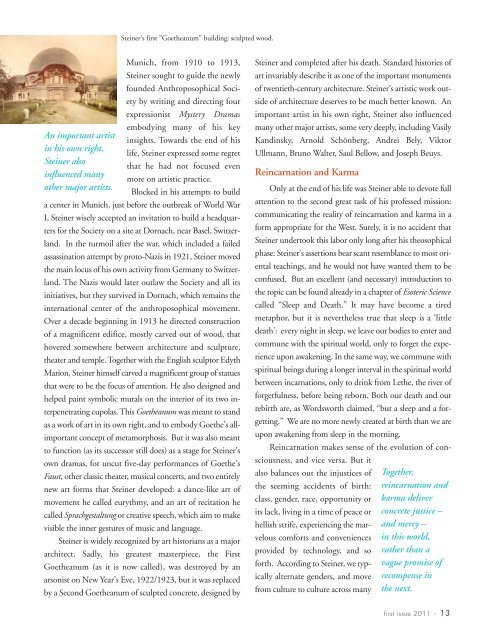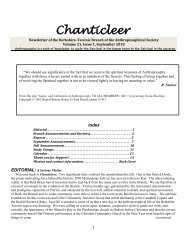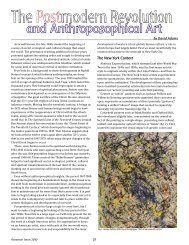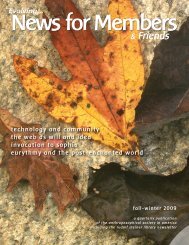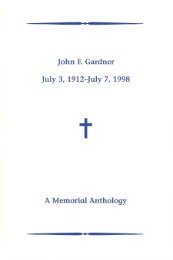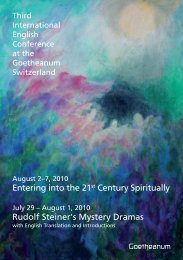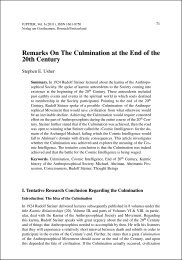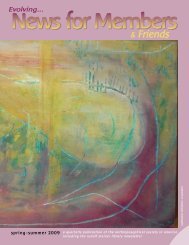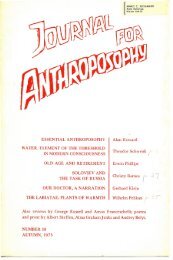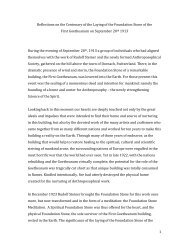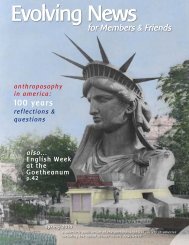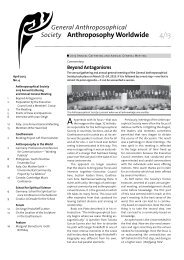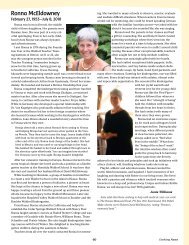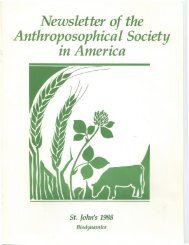Rudolf Steiner's Vision for the Future - Anthroposophical Society in ...
Rudolf Steiner's Vision for the Future - Anthroposophical Society in ...
Rudolf Steiner's Vision for the Future - Anthroposophical Society in ...
Create successful ePaper yourself
Turn your PDF publications into a flip-book with our unique Google optimized e-Paper software.
<strong>Ste<strong>in</strong>er's</strong> first "Goe<strong>the</strong>anum" build<strong>in</strong>g: sculpted wood.<br />
Munich, from 1910 to 1913,<br />
Ste<strong>in</strong>er sought to guide <strong>the</strong> newly<br />
founded <strong>Anthroposophical</strong> <strong>Society</strong><br />
by writ<strong>in</strong>g and direct<strong>in</strong>g four<br />
expressionist Mystery Dramas<br />
embody<strong>in</strong>g many of his key<br />
An important artist<br />
<strong>in</strong>sights. Towards <strong>the</strong> end of his<br />
<strong>in</strong> his own right,<br />
life, Ste<strong>in</strong>er expressed some regret<br />
Ste<strong>in</strong>er also<br />
that he had not focused even<br />
<strong>in</strong>fluenced many<br />
more on artistic practice.<br />
o<strong>the</strong>r major artists.<br />
Blocked <strong>in</strong> his attempts to build<br />
a center <strong>in</strong> Munich, just be<strong>for</strong>e <strong>the</strong> outbreak of World War<br />
I, Ste<strong>in</strong>er wisely accepted an <strong>in</strong>vitation to build a headquarters<br />
<strong>for</strong> <strong>the</strong> <strong>Society</strong> on a site at Dornach, near Basel, Switzerland.<br />
In <strong>the</strong> turmoil after <strong>the</strong> war, which <strong>in</strong>cluded a failed<br />
assass<strong>in</strong>ation attempt by proto-Nazis <strong>in</strong> 1921, Ste<strong>in</strong>er moved<br />
<strong>the</strong> ma<strong>in</strong> locus of his own activity from Germany to Switzerland.<br />
The Nazis would later outlaw <strong>the</strong> <strong>Society</strong> and all its<br />
<strong>in</strong>itiatives, but <strong>the</strong>y survived <strong>in</strong> Dornach, which rema<strong>in</strong>s <strong>the</strong><br />
<strong>in</strong>ternational center of <strong>the</strong> anthroposophical movement.<br />
Over a decade beg<strong>in</strong>n<strong>in</strong>g <strong>in</strong> 1913 he directed construction<br />
of a magnificent edifice, mostly carved out of wood, that<br />
hovered somewhere between architecture and sculpture,<br />
<strong>the</strong>ater and temple. Toge<strong>the</strong>r with <strong>the</strong> English sculptor Edyth<br />
Marion, Ste<strong>in</strong>er himself carved a magnificent group of statues<br />
that were to be <strong>the</strong> focus of attention. He also designed and<br />
helped pa<strong>in</strong>t symbolic murals on <strong>the</strong> <strong>in</strong>terior of its two <strong>in</strong>terpenetrat<strong>in</strong>g<br />
cupolas. This Goe<strong>the</strong>anum was meant to stand<br />
as a work of art <strong>in</strong> its own right, and to embody Goe<strong>the</strong>’s allimportant<br />
concept of metamorphosis. But it was also meant<br />
to function (as its successor still does) as a stage <strong>for</strong> Ste<strong>in</strong>er’s<br />
own dramas, <strong>for</strong> uncut five-day per<strong>for</strong>mances of Goe<strong>the</strong>’s<br />
Faust, o<strong>the</strong>r classic <strong>the</strong>ater, musical concerts, and two entirely<br />
new art <strong>for</strong>ms that Ste<strong>in</strong>er developed: a dance-like art of<br />
movement he called eurythmy, and an art of recitation he<br />
called Sprachgestaltung or creative speech, which aim to make<br />
visible <strong>the</strong> <strong>in</strong>ner gestures of music and language.<br />
Ste<strong>in</strong>er is widely recognized by art historians as a major<br />
architect. Sadly, his greatest masterpiece, <strong>the</strong> First<br />
Goe<strong>the</strong>anum (as it is now called), was destroyed by an<br />
arsonist on New Year’s Eve, 1922/1923, but it was replaced<br />
by a Second Goe<strong>the</strong>anum of sculpted concrete, designed by<br />
Ste<strong>in</strong>er and completed after his death. Standard histories of<br />
art <strong>in</strong>variably describe it as one of <strong>the</strong> important monuments<br />
of twentieth-century architecture. Ste<strong>in</strong>er’s artistic work outside<br />
of architecture deserves to be much better known. An<br />
important artist <strong>in</strong> his own right, Ste<strong>in</strong>er also <strong>in</strong>fluenced<br />
many o<strong>the</strong>r major artists, some very deeply, <strong>in</strong>clud<strong>in</strong>g Vasily<br />
Kand<strong>in</strong>sky, Arnold Schönberg, Andrei Bely, Viktor<br />
Ullmann, Bruno Walter, Saul Bellow, and Joseph Beuys.<br />
Re<strong>in</strong>carnation and Karma<br />
Only at <strong>the</strong> end of his life was Ste<strong>in</strong>er able to devote full<br />
attention to <strong>the</strong> second great task of his professed mission:<br />
communicat<strong>in</strong>g <strong>the</strong> reality of re<strong>in</strong>carnation and karma <strong>in</strong> a<br />
<strong>for</strong>m appropriate <strong>for</strong> <strong>the</strong> West. Surely, it is no accident that<br />
Ste<strong>in</strong>er undertook this labor only long after his <strong>the</strong>osophical<br />
phase: Ste<strong>in</strong>er’s assertions bear scant resemblance to most oriental<br />
teach<strong>in</strong>gs, and he would not have wanted <strong>the</strong>m to be<br />
confused. But an excellent (and necessary) <strong>in</strong>troduction to<br />
<strong>the</strong> topic can be found already <strong>in</strong> a chapter of Esoteric Science<br />
called “Sleep and Death.” It may have become a tired<br />
metaphor, but it is never<strong>the</strong>less true that sleep is a ‘little<br />
death’: every night <strong>in</strong> sleep, we leave our bodies to enter and<br />
commune with <strong>the</strong> spiritual world, only to <strong>for</strong>get <strong>the</strong> experience<br />
upon awaken<strong>in</strong>g. In <strong>the</strong> same way, we commune with<br />
spiritual be<strong>in</strong>gs dur<strong>in</strong>g a longer <strong>in</strong>terval <strong>in</strong> <strong>the</strong> spiritual world<br />
between <strong>in</strong>carnations, only to dr<strong>in</strong>k from Le<strong>the</strong>, <strong>the</strong> river of<br />
<strong>for</strong>getfulness, be<strong>for</strong>e be<strong>in</strong>g reborn. Both our death and our<br />
rebirth are, as Wordsworth claimed, “but a sleep and a <strong>for</strong>gett<strong>in</strong>g.”<br />
We are no more newly created at birth than we are<br />
upon awaken<strong>in</strong>g from sleep <strong>in</strong> <strong>the</strong> morn<strong>in</strong>g.<br />
Re<strong>in</strong>carnation makes sense of <strong>the</strong> evolution of consciousness,<br />
and vice versa. But it<br />
also balances out <strong>the</strong> <strong>in</strong>justices of Toge<strong>the</strong>r,<br />
<strong>the</strong> seem<strong>in</strong>g accidents of birth: re<strong>in</strong>carnation and<br />
class, gender, race, opportunity or karma deliver<br />
its lack, liv<strong>in</strong>g <strong>in</strong> a time of peace or concrete justice –<br />
hellish strife, experienc<strong>in</strong>g <strong>the</strong> mar- and mercy –<br />
velous com<strong>for</strong>ts and conveniences <strong>in</strong> this world,<br />
provided by technology, and so ra<strong>the</strong>r than a<br />
<strong>for</strong>th. Accord<strong>in</strong>g to Ste<strong>in</strong>er, we typ- vague promise of<br />
ically alternate genders, and move recompense <strong>in</strong><br />
from culture to culture across many <strong>the</strong> next.<br />
first issue 2011 • 13


